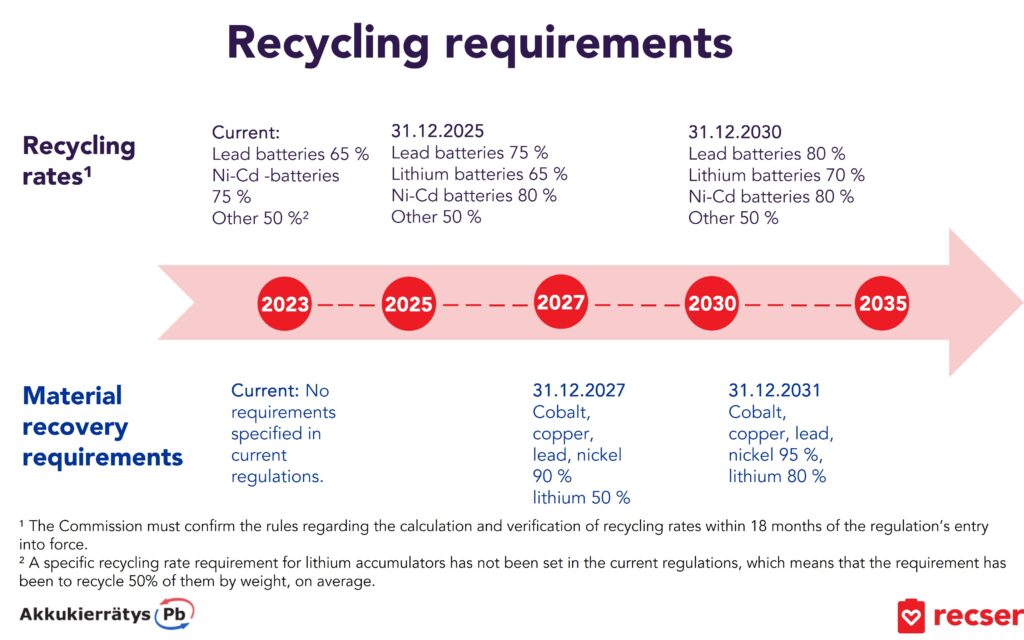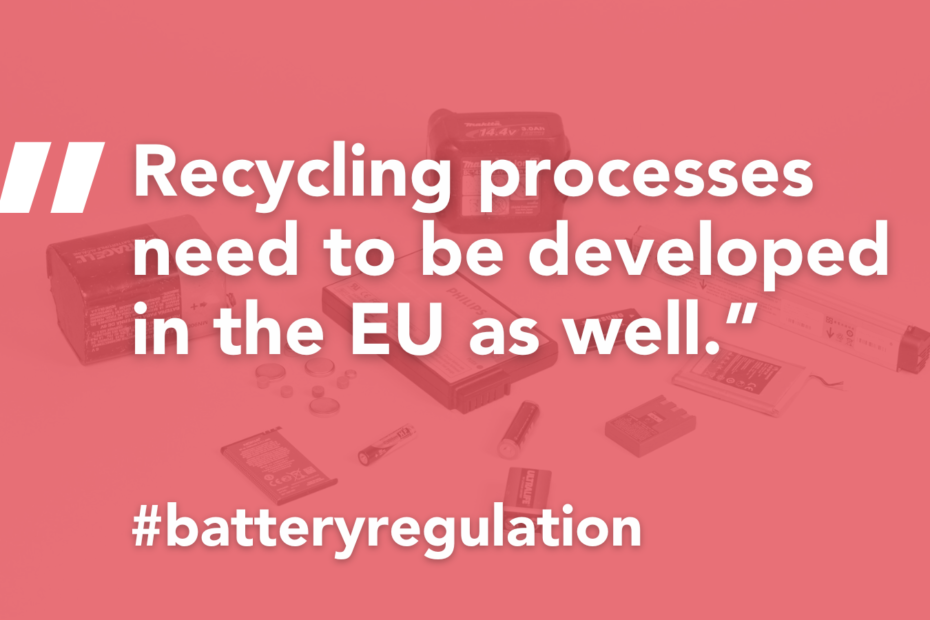The number of accumulators on the European market has been predicted to multiply ten-fold by 2030. All accumulators taken out of use should be recycled to ensure the sufficiency of raw materials, but smaller accumulators seem to have been omitted in the development of recycling processes.
Lithium-ion accumulators are taking over the accumulator market at a rapid pace. Accumulator solutions are needed to electrify cars and store renewable energy, but significant growth is also happening in the numbers of wireless tools and electric light means of transport, such as electric bicycles.
The EU is also paying attention, as the Batteries Regulation, due to enter into force soon, specifies demanding recycling requirements for lithium-ion accumulators. In 2026 and 2031, at least 65% and 70% of the separately collected lithium-ion accumulator must be recycled as materials, respectively.
In addition, material-specific recycling requirements have been specified for the most common lithium-ion accumulator materials (cobalt, lithium and nickel), as well as the blending obligation, i.e. the obligation to use a specific amount of recycled raw materials in new accumulators.
“The current recycling requirement is 50%, so major changes are coming. The aim of the demanding requirements is to accelerate the development of the circular economy of accumulators and reduce Europe’s dependency on materials from third countries,” says Managing Director Liisa-Marie Stenbäck from Recser Oy, the organisation responsible for collecting and recycling batteries and small accumulators in Finland.

It is particularly challenging to meet the recycling requirements of certain lithium-ion accumulators, which sorting plants are full of at the moment. In between the lithium-ion accumulators used in small smart devices and the large accumulators used in electric cars, there is a growing group of medium-sized accumulators, including, for example, the accumulators of wireless tools and 1electric means of transport, which no one seems to want to accept.
The common denominator between lithium-ion accumulators suitable for different purposes is their operating principle
Despite its name, a lithium-ion accumulator contains only a few percent of lithium. “Lithium-ion accumulator” is a generic term for accumulators with an operating principle based on the movement of lithium ions between negatively charged anodes and positively charged cathodes.
The name “lithium accumulator” does not specify the raw material content of the accumulator. All lithium accumulators typically contain copper, aluminium and graphite, but the content of cobalt, nickel, manganese, iron, phosphate and other materials in the composition of the cathode may vary remarkably.
So far, the most valuable raw material recovered in the recycling processes of lithium accumulators has been cobalt. Because of this, lithium-ion accumulators are divided into accumulators with high or low cobalt content for recycling purposes.
High cobalt content allows for a large energy density, which is why it has been a popular solution for smart devices, which often require a small and light accumulator. The less the size of the accumulator matters, the more likely it is that the cobalt content is low due to the price and availability of cobalt. Examples of low-cobalt accumulators include the medium-sized accumulators for wireless tools and electric light means of transport, which the storages of recycling plants are currently full of.
The typical type of large lithium-ion accumulators used, for example, in forklifts, is the lithium-ferro phosphate (LFP) accumulator. which uses iron and phosphate instead of cobalt, nickel and other common lithium-ion accumulator materials.2
Recycling medium-sized, low-cobalt lithium-ion accumulators poses the greatest challenge. The chemistry used in these accumulators varies a lot and the raw material content cannot be determined from the label.
“If the content of an accumulator is highly varied, it is difficult to separate, and the black mass resulting from recycling can contain almost anything. This mixed content is not popular among further processing units, as it is difficult to sort important metals from it,” says Managing Director Tommi Karjalainen from recycling plant AkkuSer Oy, who provide sorting services for the batteries and accumulators collected by Recser and recycling services for accumulators with nickel and high cobalt content in Finland.
Demand for recycling capacity all over Europe
“The recycling of lithium-ion accumulators has been developed in Europe for a long time but, nevertheless, the storages of sorting plants are piled with medium-sized, low-cobalt lithium-ion accumulators that are used in wireless tools and electric means of transport,” says Karjalainen.
Asians are interested in these accumulators as well. The processing of accumulator materials and the production of accumulators is still largely centralised in Asia, where even indeterminate content can be sold.3 Many critical materials are flowing from Europe to Asia.
According to Akkukierrätys Pb Oy Managing Director Johanna Alakerttula, who has paid close attention to the progress of the Batteries Regulation, the regulation assumes that Europe relies on European raw materials and manufacturing.
“In the end, these are critical materials that are in increasingly large demand in Europe. Processing them nearby also reduces the environmental impact caused by transportation.”
According to the goals of the Batteries Regulation, accumulators should have a recycling solution within the EU, which means that recycling processes need to be developed in the EU as well.
Could the recycling plants designed for the accumulators of electric cars also process smaller accumulators?
Recycling of low-cobalt lithium-ion accumulators in Europe is not entirely impossible. Fortum, in particular, is investing in developing the capacity for recycling the accumulators of electric cars in Finland.
The recycling plants designed for the lithium-ion accumulators of electric cars could, in principle, process other medium-sized, low-cobalt accumulators. However, according to Mari Lundström from Aalto University, who has studied the recycling of lithium-ion accumulators, the problem with small and medium-sized consumer accumulators may lie with the impurities in the mass used to produce them.
Another factor that might make it difficult to recycle low-cobalt lithium-ion accumulators is the residual charge that may cause the accumulator to short circuit and start a fire.4 Residual charge does not prevent the processing of small accumulators, and it is easier to discharge large accumulators used in electric cars. The group of random medium-sized accumulators poses a challenge, as they may need to be discharged manually one by one.
Discharging can also be made with chemical methods, in which the accumulator is immersed in a saline solution. According to Karjalainen, this method involves a risk that the accumulator stops the discharging process at some point before it is fully discharged. This means that the chemical discharging method is not very reliable. An additional challenge in recycling accumulators is the relatively low volumes.
“There cannot be hundreds of large accumulator recycling centres in Europe as the majority of accumulators are still in use. The greatest demand will be in about ten years,” says Lundström.
Although demand will grow in the next decade, the recycling capacity should be in place before. This requires investments from other parties as well.
Recyclability should be taken into account already in the design phase
Karjalainen says that it would be ideal to use the existing infrastructure in the recycling process without any major changes. In other words, the end of the life cycle should be considered already in the manufacturing phase.
Lundström also highlights the product design phase. Accumulators should be designed in a way that makes it easy to recycle them.
The Batteries Regulation aims to improve recyclability in many ways, such as requiring removable accumulators and labels and information that make it easier to recycle the accumulators and emphasising producer responsibility.
Producer responsibility means that the producer, i.e. the manufacturer or importer, must arrange the recycling of the accumulators they have placed on the market at the end of their service life at the producer’s expense. This ensures that recycling does not fully depend on the value of the raw materials recycled as recycling plants may profit from the provision of recycling services for low-cobalt accumulators, which involve a difficult recycling process.
The Batteries Regulation specifies the producer responsibility contribution adaptation principle, according to which producers are rewarded for the investments made in product design.
“Recser already distributes the costs of recycling between producers so that accumulators that are easy to recycle have a lower recycling charge than those that are more difficult to recycle,” says Liisa-Marie Stenbäck.
Research and funding required to develop the recycling technology of small accumulators
The recycling volumes of lithium-ion accumulators are still low, but they are growing. Lundström says that there are a lot of separate innovations and research topics aimed at improving recycling.
A transitional state is currently in process. However, the transition will not happen on its own. Tommi Karjalainen wishes for more legislative support and investments to increase the resources.
Stenbäck and Alakerttula also emphasise the fact that, in addition to active consumers, means to facilitate and accelerate the recycled raw material market are needed. The Batteries Regulation’s blending obligation, i.e. the obligation to use a specific amount of recycled raw materials in new accumulators, is a major reform.
In addition, the development of regulations concerning classification as waste in order to facilitate the productisation of recycled raw materials. It would also be ideal if research and development funds were also directed to the development of the recycling processes of medium-sized lithium-ion accumulators piled up in the storages of sorting plants in Finland.
“There are dozens of different accumulator projects currently in progress, but they seem to mainly concern the accumulators of electric cars. We would like to see a project that focuses on the challenges of recycling smaller lithium accumulators, as there will be much more of these collected and recycled in Finland than the accumulators of electric cars,” says Stenbäck.
[1] The number of portable, rechargeable accumulators placed on the EU market between 2010 and 2040 is predicted to increase from 330 million units in 2010 to 680 million units in 2050 (+105%). The number of accumulators used in electric means of transport on the EU market is expected to grow from fewer than one million units to 17 million units between 2010 and 2040. Waste streams will develop later on due to the reasonably long service life of lithium-ion accumulators (4–10 years on average). See: Huisman, J., Bobba, S., “Available for Collection” study on alternative collection targets for waste portable and light means of transport batteries, EUR 30746 EN, Publications Office of the European Union, Luxembourg, 2021.
[2] Read more about different lithium accumulator types: https://batteryuniversity.com/article/bu-205-types-of-lithium-ion A good article about the challenges of recycling lithium-ion accumulators (available in Finnish only): https://www.kriittisetmateriaalit.fi/litiumioniakkujen-kierratys-mustan-massan-salaisuudet-icbr2021.
[4] The fire hazard related to lithium-ion accumulators is based on the burning liquid used as the electrolyte and heat dissipation. Read more (available only in Finnish): https://www.paristokierratys.fi/blog/2020/09/15/kierrossa-tasta-syysta-kaytettyjen-litiumakkujen-ja-paristojen-virtanapojen-suojaaminen-on-erityisen-tarkeaa/
Read more about the goals and requirements of the Batteries Regulation in our articles:
- #BatteryRegulation: The upcoming Batteries Regulation of the EU emphasises producer responsibility and changes our way of using, manufacturing and recycling accumulators and batteries
- #BatteryRegulation: How Valmet Automotive is preparing for a digital battery passport
- #BatteryRegulation: New labelling on batteries promotes safety and recycling
- #BatteryRegulation: The EU aims to tighten the collection rate of batteries and accumulators and make the calculation methods more realistic
- #BatteryRegulation: Agreement finally reached on the content of the EU Batteries Regulation – what compromises were made?
This article is a part of the joint communications of the battery and accumulator producer organisations Recser Oy and Akkukierrätys Pb Oy concerning the EU Batteries Regulation. You can also subscribe to our newsletter to receive the latest news on the subject.
